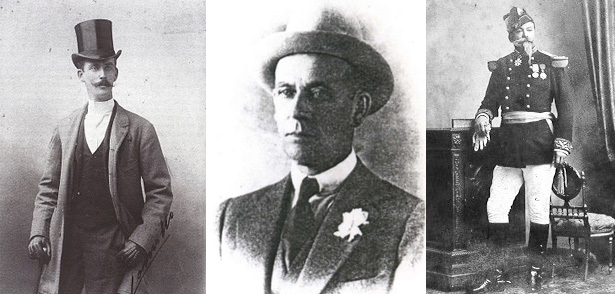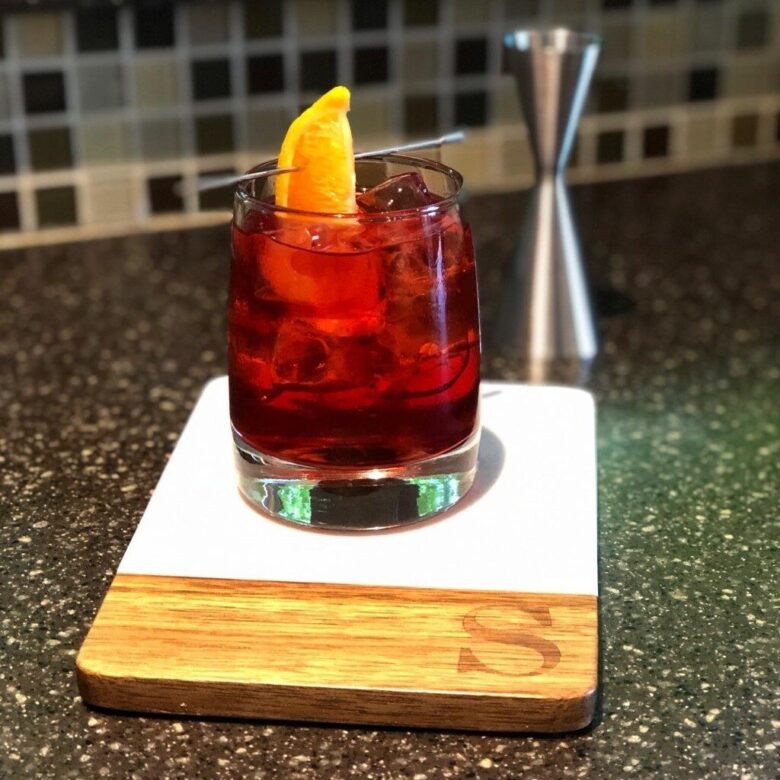The Negroni. The drink you order when you want to impress your date. The drink you order when you want to look sophisticated to your friends. The drink you order when you want to feel grown up. It’s the drink that James Bond reached for during the day, and was a favorite of Orson Wells at night, “The bitters are excellent for your liver, and the gin is bad for you. They balance each other.”
This simple drink (equal parts London dry gin, sweet vermouth, and Campari) is drunk daily as an aperitif in Italy, and has a whole week dedicated to it, starting Monday September 14th. It has a wonderful and old history, dating back to the bar where it was created, the name of its playboy, aristocratic creator – Count Camillio Negroni – as well as the name of the bartender who first mixed it – Fosco Scarselli. And like all great classic cocktails, it has a compelling counter-history, with both containing evidence supporting their version. In keeping with the era, with so many very close cocktails of the day, it is very possible that neither (or both) had a hand in its creation.
Count Camillio Negroni was just the kind of guy you wanted to have associated with the playboy nature of Italian cocktails. First, he likely wasn’t a Count. It is difficult to determine, as the Negroni name is akin to Smith in America, or Gupta in India. There are many branches on the Negroni tree, and despite much research, no one is able to verify that he was, in fact, a Count. But he did exist, as did the Caffè Casoni Bar (later renamed Caffe Giacosa) in Florence where the legend claims the drink was created. The story goes that Negroni was a wealthy playboy at the turn of the last century, and like most rich playboys of the day, he spent his youth traveling the world, chasing adventures and likely other things. He traveled to London (rumor even has it that he spent time as a bartender, where he fell in love with London dry gin). He spent time in America as a gambler in New York City and on riverboats, and played cowboy in the American West, until Prohibition was enacted, and the party ended. He traveled back to Italy and while at his favorite bar – the Caffè Casoni – in 1919 asked the bartender to make him an Americano but replace the soda water with London dry gin to give it a little more heft. He loved it so much that he began ordering it regularly, and others began asking for one of ‘Count Negroni’s’ drinks as well. And the rest is (kind of) history. The family is able to provide letters that support the Count’s claim.

Count Camillio Negroni was just the kind of guy you wanted to have associated with the playboy nature of Italian cocktails. First, he likely wasn’t a Count. It is difficult to determine, as the Negroni name is akin to Smith in America, or Gupta in India. There are many branches on the Negroni tree, and despite much research, no one is able to verify that he was, in fact, a Count. But he did exist, as did the Caffè Casoni Bar (later renamed Caffe Giacosa) in Florence where the legend claims the drink was created. The story goes that Negroni was a wealthy playboy at the turn of the last century, and like most rich playboys of the day, he spent his youth traveling the world, chasing adventures and likely other things. He traveled to London (rumor even has it that he spent time as a bartender, where he fell in love with London dry gin). He spent time in America as a gambler in New York City and on riverboats, and played cowboy in the American West, until Prohibition was enacted, and the party ended. He traveled back to Italy and while at his favorite bar – the Caffè Casoni – in 1919 asked the bartender to make him an Americano but replace the soda water with London dry gin to give it a little more heft. He loved it so much that he began ordering it regularly, and others began asking for one of ‘Count Negroni’s’ drinks as well. And the rest is (kind of) history. The family is able to provide letters that support the Count’s claim.

“You say you can drink, smoke, & I am sure laugh, just as much as ever. I feel you are not much to be pitied! You must not take more than 20 Negronis in one day!” (letter to Camillo Negroni from Frances Harper of Chelsea, London, dated October 13, 1930)
Great story, right? Based on a real person, with some anecdotal evidence supporting the story. Hold that thought.
Recently, an alternate story has emerged that has even more evidence. But this one isn’t an Italian story – it’s about a Frenchman who created the drink In Africa! General Pascal Oliver Comte de Negroni may very well be the actual creator of the Negoni. Fortunately, the General is every bit as colorful as the Count. Pascal was born in 1829, and at 18 joined the French Army, in the elite Cuirassier (French armored shock cavalry). He spent time as a prisoner and was awarded the highest decoration in the French Military (Voir Légion d’honneur Commandeur) for leading a heroic charge during the Battle of Reichshoffen. Sometime around 1870, during the Franco-Prussian War of 1870 (war over disputed land between current day France and German), Pascal and his fellow brass visited the Lunéville Officers Club and he introduced them to his signature ‘vermouth-based cocktail’, which he claimed he created years before while in Senegal.

Left to right: Pascal & Roche Negroni in formal Cuirassiers officers dress
“[translated] Incidentally, did you know that the vermouth-based cocktail that I invented in Saint Louis is a great hit at the Lunéville officers club?” (letter from Pascal to his brother Roche)
It is said that he created the drink in to commemorate his marriage to Blanche Gérard-Fontallard (May 6th, 1857). At the time Pascal was posted as Base Commander to the French colony of Saint Louis in Senegal, West Africa (1855-1865), and several other letters from his time in Senegal have surfaced that mention his namesake drink. The only fly in the ointment is that Campari – one of the three ingredients in the Negroni – was not invented until 1860. Three years after he supposedly created it.
The first actual recipe (with its current name) isn’t found in print until 1955 in two different publications, ‘The U.K.B.G Guide to Drinks’ compiled by the United Kingdom Bartender’s Guild, and ‘Cocktail and Oscar Haimo’s Wine Digest’ published in New York. Decades after its supposed creation. The Pascal story only references a vermouth-based cocktail. The Camillio story includes all three ingredients, but no proportions. Cocktail books of the era are littered with drinks that closely resemble the Negroni, but with different proportions and names. So, it is possible that they are part of a number of people that had a hand in this iconic drink.
There are two schools of thought with the Negroni. One is that you treat the three ingredients as if they are the Holy Trinity. Equal, and beyond improvement. Any modification is blasphemy. The other school recognizes that we all process bitter tastes differently – so liberty can be taken with the proportions to match individual palettes.
Personally, I’m a fan of the latter. I also concur with Anthony Bourdain’s assessment of the Negroni – his favorite cocktail:
“A Negroni is a perfect drink as far as I’m concerned, “says Bourdain, adding, “Its three liquors that I’m not particularly interested in . . . But put them together with a slice of orange. It works … That first sip is confusing and not particularly pleasant. But man, it grows on you.”
I’ll drink to that.
The Negroni (from above)
1/3 Campari
1/3 sweet vermouth
1/3 London dry gin
Orange wedge garnish
Add everything to an Old Fashioned glass with ice and give it a gentle stir. Add the orange slice and serve.
- Bill Stott
AotCB-009
Instagram@architecture_of_the_cocktail



